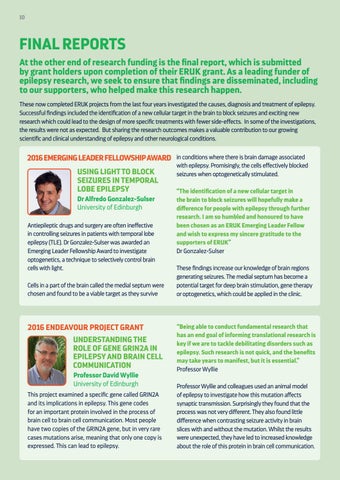10
FINAL REPORTS At the other end of research funding is the final report, which is submitted by grant holders upon completion of their ERUK grant. As a leading funder of epilepsy research, we seek to ensure that findings are disseminated, including to our supporters, who helped make this research happen. These now completed ERUK projects from the last four years investigated the causes, diagnosis and treatment of epilepsy. Successful findings included the identification of a new cellular target in the brain to block seizures and exciting new research which could lead to the design of more specific treatments with fewer side-effects. In some of the investigations, the results were not as expected. But sharing the research outcomes makes a valuable contribution to our growing scientific and clinical understanding of epilepsy and other neurological conditions.
2016 EMERGING LEADER FELLOWSHIP AWARD USING LIGHT TO BLOCK SEIZURES IN TEMPORAL LOBE EPILEPSY Dr Alfredo Gonzalez-Sulser University of Edinburgh
Antiepileptic drugs and surgery are often ineffective in controlling seizures in patients with temporal lobe epilepsy (TLE). Dr Gonzalez-Sulser was awarded an Emerging Leader Fellowship Award to investigate optogenetics, a technique to selectively control brain cells with light. Cells in a part of the brain called the medial septum were chosen and found to be a viable target as they survive
2016 ENDEAVOUR PROJECT GRANT UNDERSTANDING THE ROLE OF GENE GRIN2A IN EPILEPSY AND BRAIN CELL COMMUNICATION Professor David Wyllie University of Edinburgh This project examined a specific gene called GRIN2A and its implications in epilepsy. This gene codes for an important protein involved in the process of brain cell to brain cell communication. Most people have two copies of the GRIN2A gene, but in very rare cases mutations arise, meaning that only one copy is expressed. This can lead to epilepsy.
in conditions where there is brain damage associated with epilepsy. Promisingly, the cells effectively blocked seizures when optogenetically stimulated. “The identification of a new cellular target in the brain to block seizures will hopefully make a difference for people with epilepsy through further research. I am so humbled and honoured to have been chosen as an ERUK Emerging Leader Fellow and wish to express my sincere gratitude to the supporters of ERUK” Dr Gonzalez-Sulser These findings increase our knowledge of brain regions generating seizures. The medial septum has become a potential target for deep brain stimulation, gene therapy or optogenetics, which could be applied in the clinic.
“Being able to conduct fundamental research that has an end goal of informing translational research is key if we are to tackle debilitating disorders such as epilepsy. Such research is not quick, and the benefits may take years to manifest, but it is essential.” Professor Wyllie Professor Wyllie and colleagues used an animal model of epilepsy to investigate how this mutation affects synaptic transmission. Surprisingly they found that the process was not very different. They also found little difference when contrasting seizure activity in brain slices with and without the mutation. Whilst the results were unexpected, they have led to increased knowledge about the role of this protein in brain cell communication.
